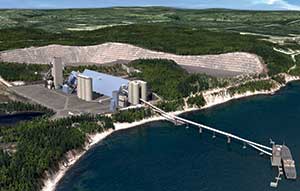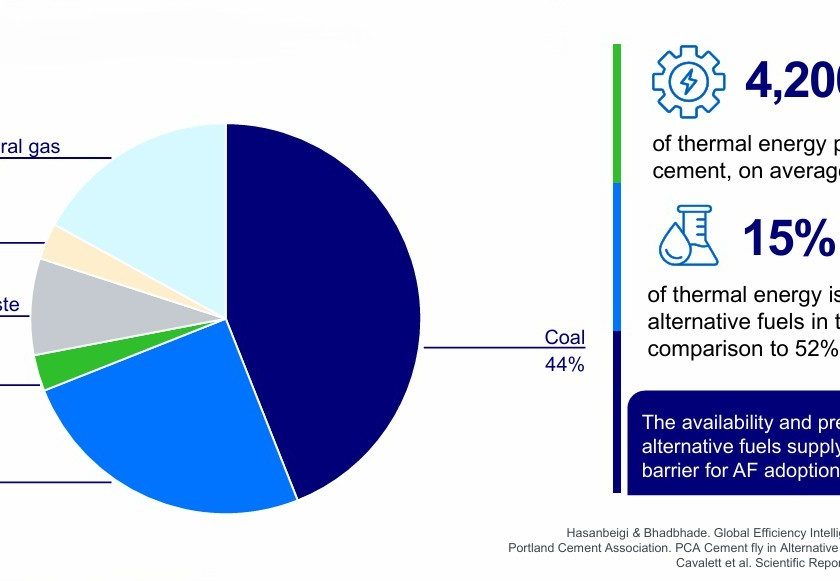New plant designed to serve Eastern markets with a price tag of almost $1 billion.
By Mark S. Kuhar and Don Marsh
 With a projected price tag nearing $1 billion, the most ambitious cement plant on the North American docket is pegged for an 850-acre greenfield on the eastern reaches of the continent, yet stands to bring a new powder option to concrete producers and contractors from New England to Mid-Atlantic markets, along with those in the eastern half of the Great Lakes.
With a projected price tag nearing $1 billion, the most ambitious cement plant on the North American docket is pegged for an 850-acre greenfield on the eastern reaches of the continent, yet stands to bring a new powder option to concrete producers and contractors from New England to Mid-Atlantic markets, along with those in the eastern half of the Great Lakes.
Late last year, McInnis Cement announced financing and receipt of final permits to spur 2014–2016 construction of a 2 million–2.5 million ton per year plant and marine terminal in Port-Daniel-Gascons, Quebec.
An idyllic plot along the Gulf of St. Lawrence – roughly 450 miles northeast of Montreal, or 500 miles from Boston – might not seem like the optimal point to penetrate major U.S. and Canadian cement markets. Logistics, provincial and state politics or regulations, plus geology prove otherwise: With deep water load out, the McInnis Cement mill will be able to deliver material to Atlantic coast points south or St. Lawrence Seaway points west in two to three sailing days.
|
Environment: Central to the Vision |
|
McInnis Cement officials view the environment as “central to our vision.” Port-Daniel-Gascons will harbor what they see as one of the world’s most efficient and environmentally responsible cement operations. The plant will feature:
“Cement Plant Development Project in the Territory of Port-Daniel-Gascons,” the final report to the Québec Ministry of Sustainable Development, Environment, Wildlife and Parks, stipulates preservation of a wooded, 35-meter buffer strip between the cement plant’s 90-acre area of operation and the right-of-way of any public road in any area within 100 metres of Highway 132, coastal Quebec’s circumferential route. Taking a page from California regulators, the report also notes among many construction and operating phase pollution controls: “Concrete mixers used during the construction phase will be cleaned systematically on an impervious surface so the water can be collected and treated as needed.” |
New Cement Company
“We are building a new cement company. Not a new cement plant,” said CEO Christian Gagnon, a Lafarge North America and Lafarge Group veteran whose executive assignments spanned Greece to British Columbia. “One of our main selling points is that we are not importers. We have a model similar to legacy Great Lakes cement mills that were remotely located but capable of serving multiple big markets. Port-Daniel-Gascons is excellent in all regards: Good virgin material and power sources for cement production. Strong local community support and labor force. And a location capable of serving captive terminals in a market radius with approximately 30 million tons of clinker capacity.”
“Many concrete producers and contractors in Northeast and Great Lakes markets are sourcing cement from dated mills,” added Senior Vice President, Commercial and Logistics Jim Brasselton, who joined McInnis following a long Lafarge North America tenure, and remains based in northern Virginia. “Nearly 25 million tons of the capacity in our market radius is from plants 50 years or older. When factoring the aged mill factor, along with projected growth in U.S. cement consumption, and uncertainty with overseas imports, buyers will need to reevaluate their cement supply chains over the next three to five years.”
In contrast to peers in the Northeast U.S., especially along the Hudson River, the Quebec government and agencies closer to Port-Daniel-Gascons embrace the idea of an advanced cement mill, he affirms.
Support on the provincial and local level reflects financial and environmental considerations, as the McInnis Cement operation will:
- Be built with the backing of some of the province’s best known business executives.
- See up to 600 jobs created during the construction phase, while ultimately providing direct and indirect employment for up to 400.
- Run on a combination of Hydro Quebec power (clinker grinding, all other electricity requirements) and petroleum coke (preheater and kiln) sourced from a refinery.
- Be equipped for compliance with the Environmental Protection Agency’s National Emissions Standards for Hazardous Air Pollutants (NESHAP, 2015–16 compliance targets), whose mercury thresholds are 1/10th those of Environment Canada’s.
 Environmental, Financial Soundness
Environmental, Financial Soundness
NESHAP is compelling U.S. cement mills coast to coast to invest in new emissions scrubber equipment to lower release of mercury and sulfur, levels of which vary depending on coal or other fuel source, and the limestone processed for raw kiln feed.
McInnis Cement officials plan to include the newest emissions control and exhaust treatment devices, but will have an added advantage on the NESHAP compliance route traceable to Quebec geology.
“Port-Daniel-Gascons is near the starting point of the Appalachians,” said Braselton. “Our deposit has some of the chain’s oldest limestone, aged to a point of very low mercury content.”
Another factor favoring the new plant’s emissions inventory, he adds, is the petroleum coke fueling the kiln, which has lower mercury content than the coal typically used in cement plants.
McInnis Cement is the evolution of a business plan dating to 1995, when Cimbec Inc. began preliminary work for a mill along the Gulf of St. Lawrence, including delivery of an Environmental Repercussions Study to the Quebec Ministry of the Environment, now the Ministry of Sustainable Development, Environment, Wildlife and Parks.
After the entry and exit of certain partners, plus permitting and construction plans mapped around two challenging business cycles, a new lead investor, Beaudier Group, closed in late-2011 on a controlling Cimbec stake.
Beaudier is the investment arm of the Beaudoin family, a majority shareholder in two of Quebec’s preeminent corporate brands: Bombardier, the world’s third largest manufacturer of business and commercial aircraft; and, Bombardier Recreational Products, whose Ski-Doo, Sea-Doo and Can-Am brands are well known among snowmobile, watercraft and road vehicle owners.
Its arrival triggered commissioning of an updated Environmental Repercussions Study for the Port-Daniel-Gascons site in 2012, and recruitment of the Lafarge veterans to spearhead plant and terminal construction, and chart material distribution and marketing.
Cimtec was renamed McInnis Cement in August 2013, while the final Repercussions Study was submitted to Quebec Ministry officials in November 2013 – one of the last steps leading to the awarding of cement plant and terminal equipment and construction contracts.
Baudier officials underscore their confidence in the Port-Daniel-Gascons site’s potential, and have committed significant capital to ensure McInnis Cement has the support and resources it needs to make the plant a reality.
Don Marsh is editor of Concrete Products, sister publication of Rock Products and Cement Americas.
|
Mcinnis Cement Launches New Website |
|
McInnis Cement is pleased to announce the launch of its new website for its Port-Daniel-Gascons cement plant project. The bilingual website is available at www.mcinniscement.com and www.cimentmcinnis.com. The website contains a broad array of information, including a 3D animation showcasing the project in its setting. In addition, users will be able to get information about the project in its current form, as well as answers to the most frequently asked questions. “The website is a reflection of our commitment to the population to keep them well-informed about our project. It will be regularly updated with the latest information. In fact, we would like to reiterate that environmental updates will be available on our website once the Ministry of Environment has completed its analysis to its satisfaction,” said Christian Gagnon, president and chief executive officer, McInnis Cement. |




